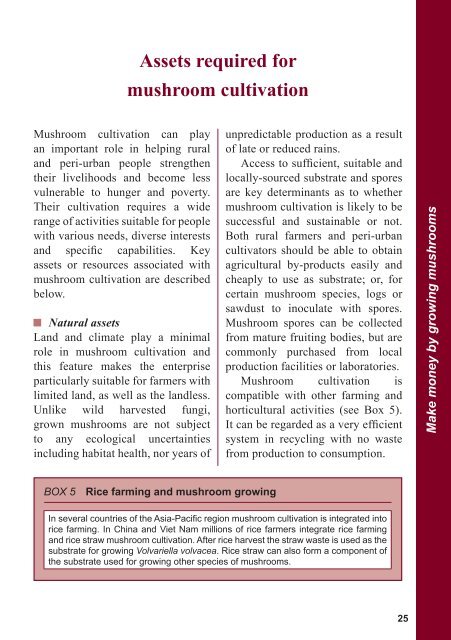You also want an ePaper? Increase the reach of your titles
YUMPU automatically turns print PDFs into web optimized ePapers that Google loves.
Assets required for<br />
<strong>mushroom</strong> cultivation<br />
Mushroom cultivation can play<br />
an important role in helping rural<br />
and peri-urban people strengthen<br />
their livelihoods and become less<br />
vulnerable to hunger and poverty.<br />
Their cultivation requires a wide<br />
range of activities suitable for people<br />
with various needs, diverse interests<br />
and specific capabilities. Key<br />
assets or resources associated with<br />
<strong>mushroom</strong> cultivation are described<br />
below.<br />
Natural assets<br />
Land and climate play a minimal<br />
role in <strong>mushroom</strong> cultivation and<br />
this feature makes the enterprise<br />
particularly suitable for farmers with<br />
limited land, as well as the landless.<br />
Unlike wild harvested fungi,<br />
grown <strong>mushroom</strong>s are not subject<br />
to any ecological uncertainties<br />
including habitat health, nor years of<br />
unpredictable production as a result<br />
of late or reduced rains.<br />
Access to sufficient, suitable and<br />
locally-sourced substrate and spores<br />
are key determinants as to whether<br />
<strong>mushroom</strong> cultivation is likely to be<br />
successful and sustainable or not.<br />
Both rural farmers and peri-urban<br />
cultivators should be able to obtain<br />
agricultural by-products easily and<br />
cheaply to use as substrate; or, for<br />
certain <strong>mushroom</strong> species, logs or<br />
sawdust to inoculate with spores.<br />
Mushroom spores can be collected<br />
from mature fruiting bodies, but are<br />
commonly purchased from local<br />
production facilities or laboratories.<br />
Mushroom cultivation is<br />
compatible with other <strong>farming</strong> and<br />
horticultural activities (see Box 5).<br />
It can be regarded as a very efficient<br />
system in recycling with no waste<br />
from production to consumption.<br />
Make money by growing <strong>mushroom</strong>s<br />
BOX 5 Rice <strong>farming</strong> and <strong>mushroom</strong> growing<br />
In several countries of the Asia-Pacific region <strong>mushroom</strong> cultivation is integrated into<br />
rice <strong>farming</strong>. In China and Viet Nam millions of rice farmers integrate rice <strong>farming</strong><br />
and rice straw <strong>mushroom</strong> cultivation. After rice harvest the straw waste is used as the<br />
substrate for growing Volvariella volvacea. Rice straw can also form a component of<br />
the substrate used for growing other species of <strong>mushroom</strong>s.<br />
25


